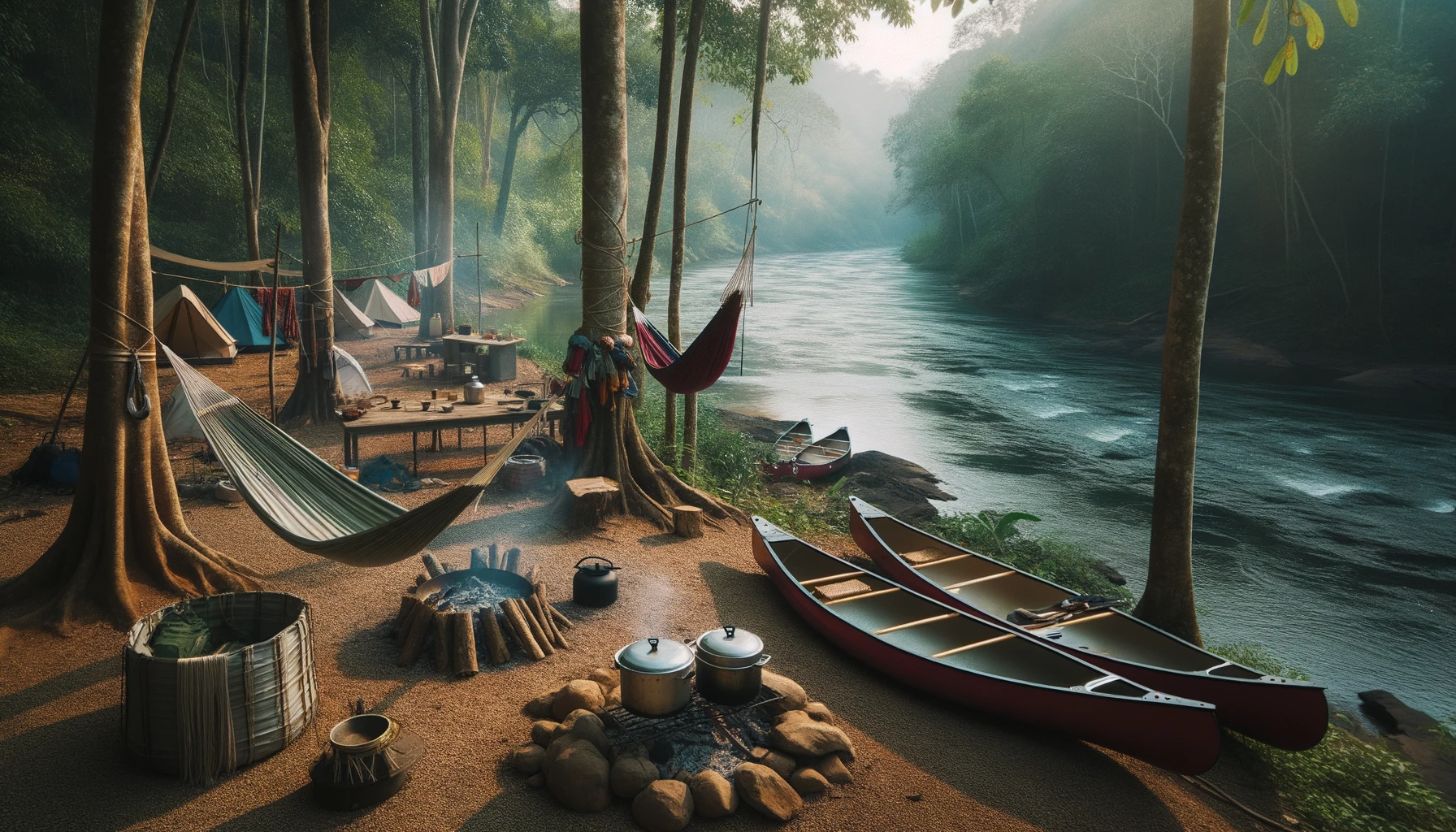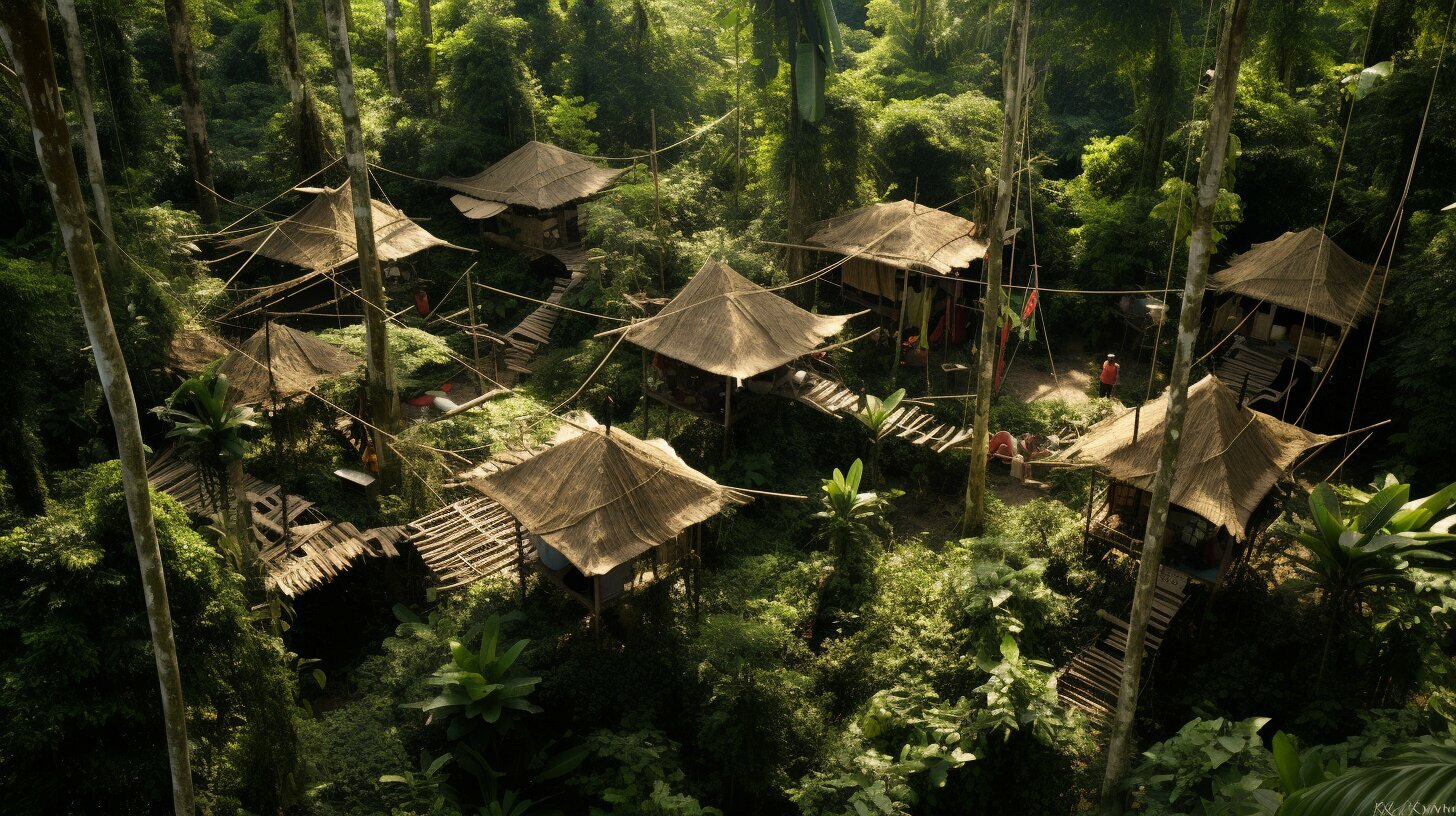Surviving in the wilderness for an extended period can be a daunting task. It requires essential techniques, skills, and a resilient mindset to encounter any challenges you may face. In this comprehensive guide, we will equip you with everything you need to know about long-term wilderness survival, from the right survival gear and camping tips to emergency preparedness and bushcraft skills.
Whether you’re planning a backcountry adventure or want to be ready for unexpected situations, this guide will provide you with invaluable knowledge and strategies to thrive in the great outdoors.
Key Takeaways
- Long-term wilderness survival requires essential skills and the right survival gear.
- Understanding the fundamentals of survival skills and a resilient mindset will help you endure extended periods in the wilderness.
- Knowing how to navigate unfamiliar terrain and coexist with wildlife is vital for outdoor survival.
- Proper planning for emergency situations and selecting appropriate survival food can make a significant difference in your survival journey.
- Building psychological and emotional resilience is essential for your overall well-being when facing long-term wilderness survival.
Understanding Long-Term Wilderness Survival
Before you start packing your bags and heading out into the wilderness, it’s important to understand the fundamentals of long-term wilderness survival. The ability to survive in the wilderness for an extended period of time requires a unique set of skills and mindset that differ from those needed for short-term camping trips or day hikes.
To master long-term wilderness survival, you need to acquire the essential survival skills that will help you thrive in the great outdoors. These skills include building shelters, finding and purifying water sources, starting a fire, and identifying edible plants and animals. Developing these skills requires practice and dedication.
Disclosure: When you buy through links on our site, we may earn an affiliate commission.
It’s also important to have the right mindset when facing the challenges of long-term wilderness survival. The ability to stay calm and assess situations quickly is crucial. You should also be comfortable with solitude and isolation, as you may not have the luxury of constant human interaction.
The Importance of Long-Term Wilderness Survival Skills
Having the right survival skills can mean the difference between life and death in the wilderness. While some skills are more important than others, it’s essential to have a basic understanding of all elements of survival.
For example, knowing how to build a shelter can protect you from the elements and keep you warm at night. You’ll also need to find and purify water sources to stay hydrated and healthy. Starting a fire is also critical for cooking food, staying warm, and signaling for help. And knowing which plants and animals are safe to eat can help you avoid potentially deadly mistakes.
It’s important to remember that acquiring the necessary skills takes time and practice. Take the time to learn about different techniques and practice them in a controlled environment before heading out into the wilderness.
Developing the Right Mindset
Surviving in the wilderness for an extended period of time requires a unique mindset. You should be able to stay calm and focused in high-stress situations, and be comfortable with isolation and solitude.
One way to develop the right mindset is to practice meditation and visualization. These techniques can help calm your mind and allow you to focus on the task at hand. You should also practice positive self-talk and affirmations, reminding yourself of your strengths and abilities.
Another important aspect of developing the right mindset is learning to live with uncertainty. In the wilderness, anything can happen, and you may not always have control over your situation. Accepting this uncertainty and remaining adaptable can help you navigate unexpected challenges.
Mastering long-term wilderness survival requires both essential skills and the right mindset. By understanding the fundamentals of survival and developing the necessary skills and mindset, you’ll be well-equipped to thrive in the wilderness for an extended period of time.

Essential Wilderness Survival Skills
When it comes to long-term wilderness survival, having the right skills is essential. Whether you’re an experienced outdoorsman or a novice looking to improve your knowledge, mastering these wilderness survival techniques will significantly increase your chances of survival.
Bushcraft Skills
Bushcraft skills refer to the traditional techniques used for living off the land in the wilderness. These skills include:
- Identifying and using natural resources for shelter, such as building debris huts or lean-tos.
- Gathering water by building a solar still or collecting rainwater.
- Creating friction fire by rubbing sticks together or using a bow drill.
- Foraging for wild edible plants and berries.
- Setting traps and snares for small game.
Having these skills can be invaluable in situations where you need to rely on the resources around you to survive. It’s essential to learn these techniques from experienced outdoor experts or by taking courses that specialize in bushcraft skills.
Survival Skills
Survival skills are broader techniques that encompass the knowledge and resources necessary to sustain yourself in the wild. Some of these skills include:
- First aid and emergency medical care.
- Navigation using a compass, map, or GPS device.
- Physical fitness and endurance training.
- Identifying and avoiding potential hazards such as poisonous plants and dangerous wildlife.
- Building and maintaining a fire.
These skills require practice and regular use to become proficient. It’s essential to test your survival skills by taking on challenging outdoor adventures that push you beyond your comfort zone.
Wilderness Survival Techniques
There are many wilderness survival techniques that can be beneficial in the long-term. These include:
- Building a sturdy shelter that can withstand the elements and provide adequate protection.
- Starting and maintaining fires for warmth, cooking, and signaling.
- Purifying water using boiling or filtration techniques.
- Using signaling devices such as mirrors, flares, or whistles to attract attention.
- Creating and using makeshift tools for hunting, fishing, and other survival tasks.
It’s essential to practice and refine these techniques before you need them. Consider taking a wilderness survival course or practicing these skills with an experienced outdoorsman to hone your abilities.
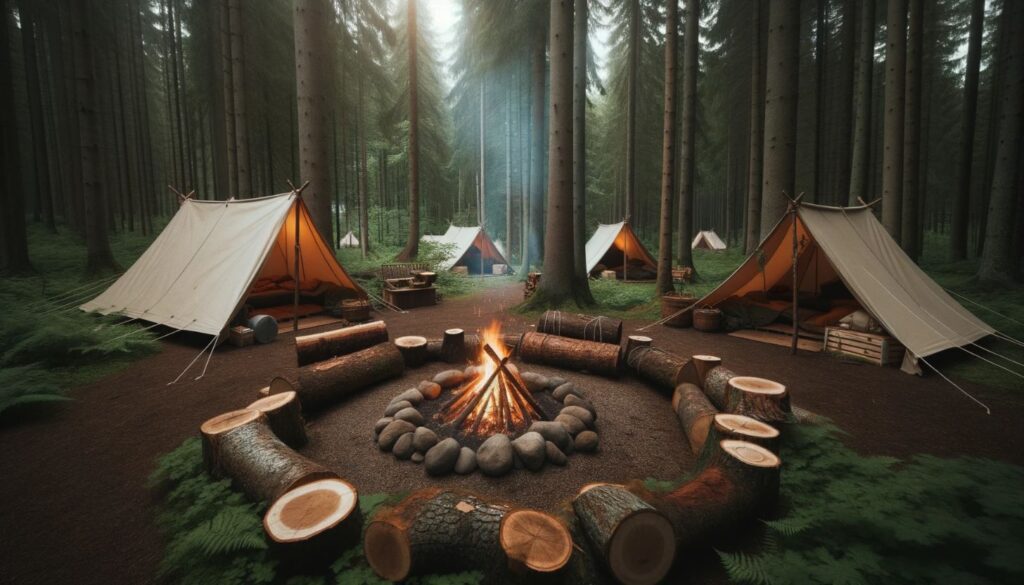
The Right Outdoor Survival Gear
Choosing the right survival gear is essential for staying safe and comfortable during long-term wilderness survival. Your gear must be durable, reliable, and versatile enough to handle any situation that comes your way.
Here’s a list of essential items to pack for your outdoor survival:
| Item | Purpose |
|---|---|
| Water Filter or Purifier | To provide safe drinking water |
| Multitool | To perform various tasks and repairs |
| Fire Starter Kit | To start fire for warmth and cooking |
| Tent or Tarp | To provide shelter from the elements |
| Sleeping Bag | To provide warmth while sleeping |
| First Aid Kit | To treat injuries and illnesses |
| Headlamp or Flashlight | To provide illumination during darkness |
| Compass or GPS | To navigate through the wilderness |
| Emergency Whistle | To signal for help |
When selecting your gear, consider the climate, terrain, and potential hazards you may face during your outdoor survival. Invest in quality gear that will last for years and don’t skimp on the essentials.
Remember, your survival gear is only as useful as your knowledge and skills to use it properly. Practice with your gear before heading out into the wilderness to ensure you’re prepared for any situation.
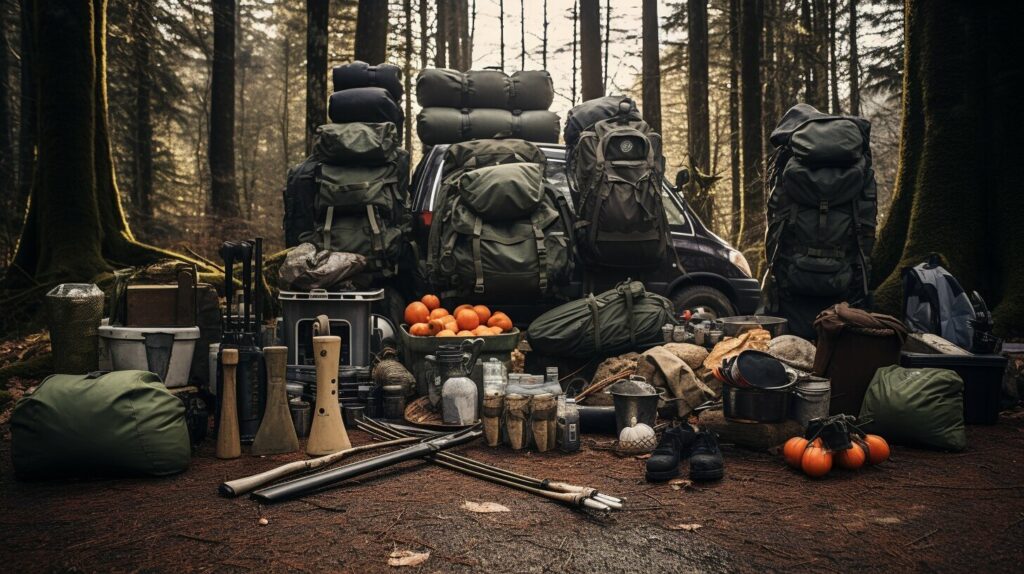
Planning for Emergency Situations
When it comes to long-term wilderness survival, it’s essential to prepare for emergency situations. Being prepared can mean the difference between life and death.
Creating a Survival Plan
The first step in emergency preparedness is to create a survival plan. Your plan should cover all aspects of survival, including food, water, shelter, and first aid. Develop a checklist of essential items to bring with you, and make sure you have enough supplies to last for an extended period. Keep your plan updated and accessible, so you can access it quickly in case of an emergency.
Understanding First Aid Techniques
Injuries can happen at any time, so it’s important to understand basic first aid techniques. Learn how to treat common injuries such as cuts, burns, and fractures. Make sure you have a comprehensive first aid kit and know how to use all the items inside.
Communication Strategies
In an emergency situation, communication can be critical. Make sure you have a reliable communication device, such as a two-way radio or satellite phone. Learn how to use distress signals, such as smoke signals or mirrors, to communicate with rescuers.
Stay Calm and Focused
When faced with an emergency, it’s important to stay calm and focused. Don’t panic or give up hope. Focus on your survival plan and take one step at a time. Remember that long-term wilderness survival requires patience, perseverance, and a positive attitude.
By preparing for emergency situations beforehand, you can increase your chances of survival in the wilderness. Keep in mind that emergencies can happen at any time, so it’s essential to be prepared for the unexpected.
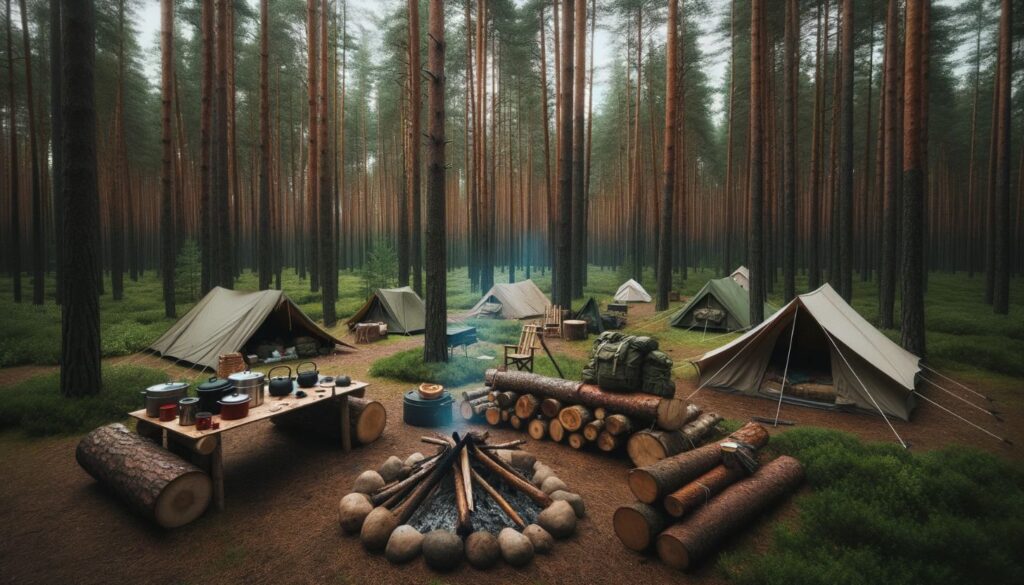
Navigating the Wild: Land and Water
When it comes to long-term wilderness survival, navigating through unfamiliar terrain is a critical skill to have. Whether you’re hiking, camping, or exploring the great outdoors, having a good sense of direction and the knowledge to read maps and use compasses is essential. However, water navigation skills are equally important if you plan on traversing rivers, lakes, or other bodies of water.
Land Navigation Techniques
Reading maps and using compasses are the two most important skills to have when navigating on land. Maps provide a wealth of information about the terrain, and with the right knowledge, you can use them to determine your location, the direction you should go, and the distance you need to travel.
Land Navigation Tips:
- Use a topographic map to get an accurate picture of the terrain.
- Use a compass to orient the map and determine your direction of travel.
- Look for prominent landmarks and terrain features to help you stay on course.
Water Navigation Skills
Water navigation skills are essential if you plan on navigating rivers, lakes, or other bodies of water. There are a few things you need to consider when navigating on water, such as understanding the flow and direction of the water, using landmarks to navigate, and having the appropriate equipment.
Water Navigation Tips:
- Use a map or chart specifically designed for water navigation.
- Use landmarks such as buoys or shoreline features to help you stay on course.
- Make sure you have the appropriate equipment, such as a life jacket, whistle, and signaling devices.
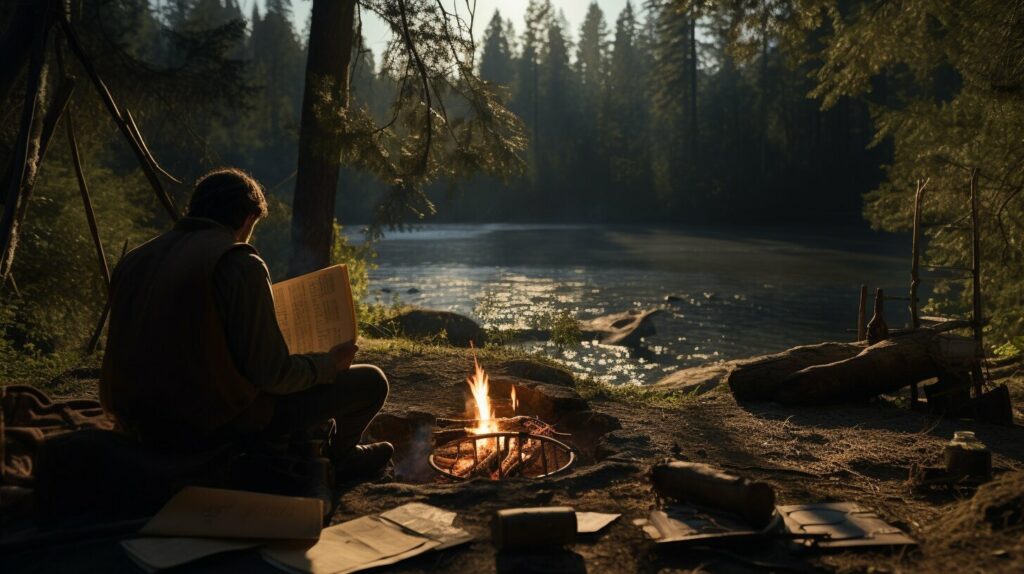
By mastering these wilderness survival techniques and navigation skills, you’ll be well-prepared to handle any challenges you may encounter while exploring the great outdoors.
Outdoor Cooking and Survival Food
When you’re in the wilderness, food is essential for survival. But finding and preparing food in the wild requires knowledge and skills.
Bushcraft skills are crucial when it comes to finding and gathering survival food. Learn to identify edible plants, like berries and mushrooms, while avoiding toxic ones. You can also hunt and fish for food, using traps, snares or improvised fishing gear like a line and hook.
Once you have gathered your food, cooking it becomes the next challenge. With limited resources, it’s essential to have camping tips for outdoor cooking. Start by building a fire and creating a simple tripod with sticks for suspending a pot over the flames.
Survival food should be lightweight, non-perishable, and high in calories. Non-perishable goods like canned food and dried fruits, nuts, and beef jerky are good choices for survival food.
If you are skilled enough, you can also hunt wild game for your survival food. This requires proper preparation, such as bringing along a hunting rifle and ammunition. Make sure that you are aware of the hunting regulations in your area before you embark on your trip.
Remember to always be mindful of food safety and hygiene when preparing your meals. Cook your food thoroughly, and clean your utensils and cooking surfaces properly, to avoid contamination.
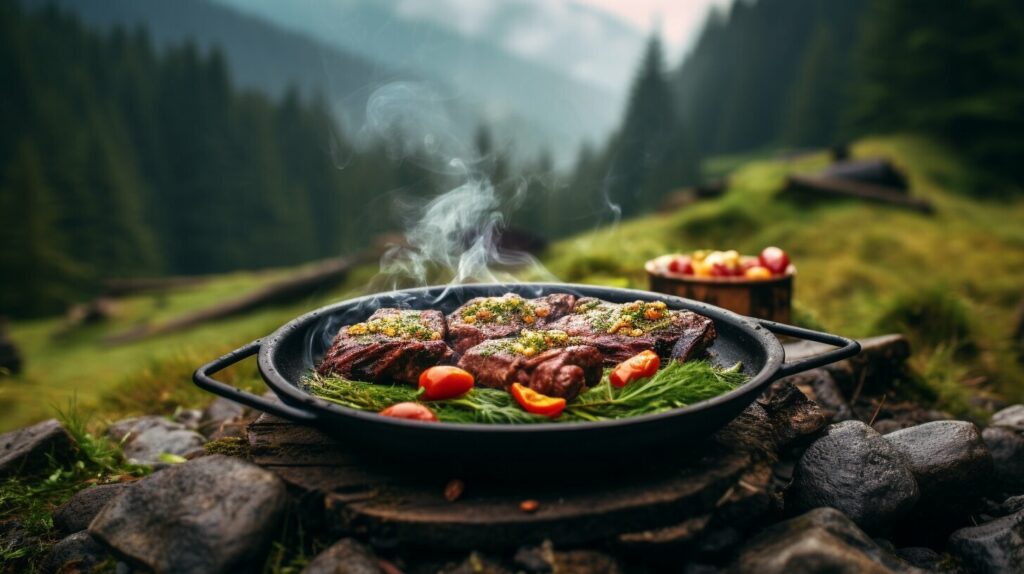
Bonus Tip: Make Your Own Jerky
Jerky is a high-protein survival food that can be made at home or in the wild. All you need is meat, salt, and a drying method.
Slice the meat into thin, even strips and sprinkle them with salt. Allow the meat to sit in the salt for a few hours to absorb the flavor. Then use a drying method, such as hanging the meat in a dry, well-ventilated area or using a dehydrator, until the jerky is dry and chewy.
With these tips and techniques, you’ll be well-prepared to find, cook, and enjoy survival food in the wilderness.
Staying Safe from Wildlife
The wilderness is a beautiful and exciting place to explore, but it’s also home to a variety of wildlife that can pose a threat to your safety. To ensure your survival, it’s essential to take precautions and know how to protect yourself in the event of an encounter. Here are some wilderness survival tips to keep in mind:
- Stay alert: Always be aware of your surroundings and keep an eye out for any signs of wildlife activity, such as tracks, droppings, or scratch marks on trees.
- Make noise: Avoid startling animals by making noise while hiking or camping. Use a bell, whistle, or even talk loudly to alert creatures of your presence.
- Store your food: Keep your food stored in airtight containers and away from your sleeping area to reduce the risk of attracting wildlife.
- Use bear-resistant containers: If you’re in bear country, consider using bear-resistant containers to store your food. These containers are designed to withstand bears’ attempts to break in.
- Know how to react: If you do encounter wildlife, it’s important to know how to react. Stay calm, avoid eye contact, and slowly back away without turning your back on the animal.
- Carry bear spray: Consider carrying bear spray as a last resort defense against bears. Make sure you know how to use it before your trip.
By following these wilderness survival tips, you can minimize the risk of encountering wildlife and stay safe during your outdoor adventures.
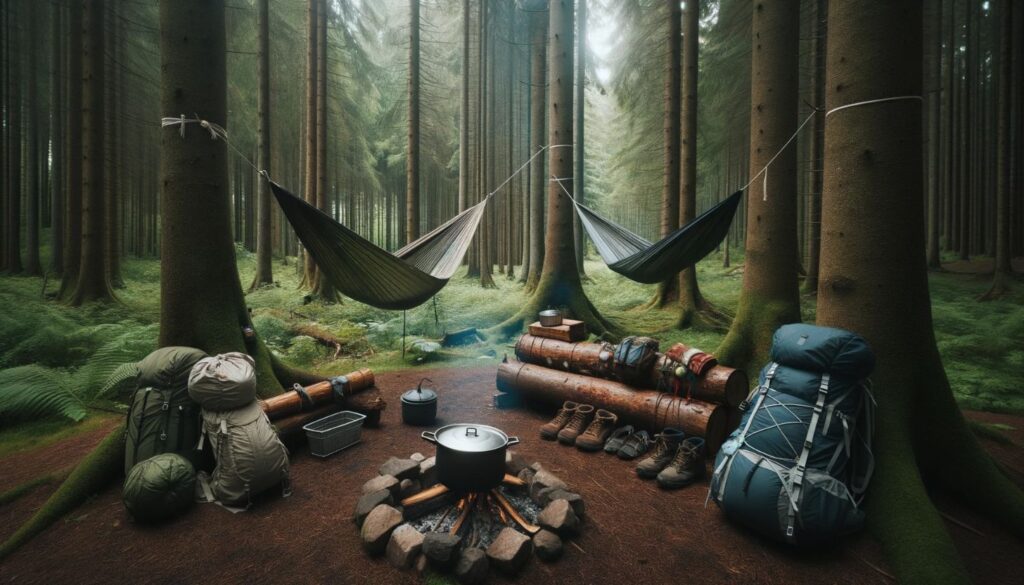
Psychological and Emotional Resilience
Long-term wilderness survival can be mentally and emotionally challenging, and it’s essential to prepare yourself for the potential psychological impact of isolation, stress, and the uncertainty of the wilderness. As much as survival skills and gear are important, mental resilience is equally significant to withstand the rigors of extended periods in the wild.
Here are some strategies to help you maintain your psychological and emotional well-being:
- Stay Optimistic: Keeping a positive attitude towards your situation can help you stay motivated and focused on survival. Reinforce positive self-talk and visualize success regularly.
- Stay Active: Exercise, such as hiking, swimming, or any physical activity, can help improve your mood and reduce stress levels.
- Meditate: Incorporating mindfulness or meditation practices in your daily routine can help reduce anxiety, improve focus, and boost resilience.
- Stay Connected: Staying in contact with family and friends can provide emotional support, encouragement, and help reduce feelings of isolation.
- Engage Creatively: Participate in activities such as writing, drawing, or playing music to help maintain a positive mindset and relieve stress.
Keep in mind that everyone’s emotional and psychological needs are different, and there’s no one-size-fits-all solution. However, by incorporating these strategies, you can build your emotional and mental fortitude to overcome the challenges of long-term wilderness survival.

“In every difficult situation is potential value. Believe this, then begin looking for it.” – Norman Vincent Peale
Conclusion
Venturing into the wilderness for an extended period of time is an immense undertaking, but profoundly rewarding. By dedicating time to honing essential skills, selecting appropriate gear, and adopting a resilient mindset, you will be prepared to confront the challenges of the wild.
Establish a solid foundation of survival knowledge, mentally condition yourself to overcome obstacles, and trust in your abilities. Adventure awaits around every corner, but you will have the tools and fortitude to thrive in the face of the unknown.
Remember, the wilderness has much to teach you, if you approach with an open mind and gritty determination. Return to civilization with invaluable lessons under your belt, feeling capable of conquering any situation.
You now possess the wisdom to brave the wilderness and emerge stronger, wiser, and more connected to the natural world. Feel empowered by your newfound mastery of survival.
FAQ
What are some essential wilderness survival skills?
Essential wilderness survival skills include building shelters, fire-making techniques, navigation, and foraging for food.
What gear do I need for long-term wilderness survival?
Important survival gear includes tools, camping equipment, emergency supplies, and appropriate clothing for different weather conditions.
How can I prepare for emergency situations in the wilderness?
To prepare for emergencies, create a survival plan, learn first aid techniques, and have communication strategies in place.
What should I do if I encounter wildlife in the wilderness?
If you encounter wildlife, it’s important to stay calm, make noise to alert them of your presence, and follow appropriate safety protocols to minimize risk.
How can I maintain psychological resilience during long-term wilderness survival?
To maintain psychological resilience, focus on staying positive, finding ways to cope with isolation, and practicing self-care techniques such as meditation or journaling.

